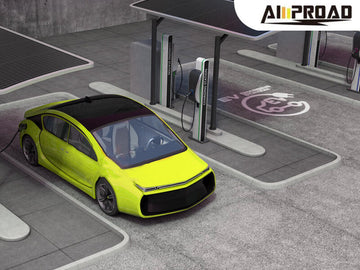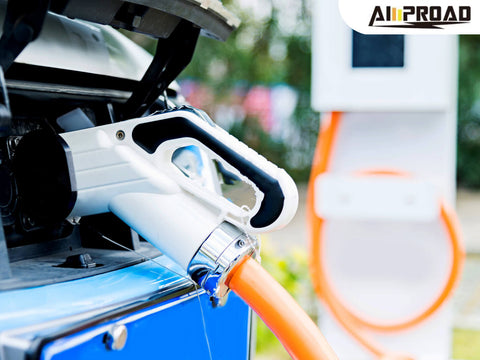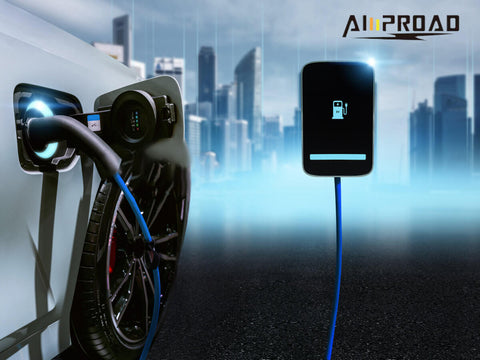
Accurate expense management for electric vehicle owners hinges on understanding the variables involved in home charging costs. Estimating these costs is achievable by analyzing information from your electricity bill.
How Much Does It Cost to Charge An EV?
Your electric bill holds valuable information that can help estimate home charging costs. Identify the cost per kilowatt-hour (kWh) listed on your bill. This is the rate you pay for electricity. Take note of any additional charges or taxes that may apply. To estimate the cost of charging your EV, you'll need to know the charging efficiency of your vehicle, usually expressed as kWh per mile.
Multiply the cost per kWh by the charging efficiency to determine the cost per mile. This figure allows you to estimate the cost of a full charge based on your EV's total battery capacity.
Let's consider a case study for better clarity. Suppose your electric rate is $0.12 per kWh, and your EV has a charging efficiency of 4 miles per kWh. The cost per mile would be $0.12 ÷ 4 = $0.03. If your EV has a battery capacity of 60 kWh, a full charge would cost $0.03 per mile × 60 kWh = $1.80.
This simple calculation provides an estimate of your home charging costs, allowing you to plan and budget effectively.
Comparing Home Charging to Fuel Fill-Ups
When considering electric vehicle (EV) ownership, comparing home charging to traditional fuel fill-ups provides valuable insights into potential cost savings. Let's delve into the comparison, examining gasoline costs for a 30 MPG car, monthly refueling expenses for gas cars, and the estimated savings associated with EV fast charging.
Gasoline Costs for a 30 MPG Car
To establish a baseline, let's consider a gas-powered car with an average fuel efficiency of 30 miles per gallon (MPG). Determine the average cost of gasoline in your area, often expressed per gallon. Multiply the cost per gallon by the car's MPG to estimate the cost per mile. For example, if gasoline costs $3 per gallon, the cost per mile would be $3 ÷ 30 MPG = $0.10 per mile.

Monthly Refueling Expenses for Gas Cars
Calculate the monthly refueling expenses for your gas car by multiplying the average monthly mileage by the cost per mile. For instance, if you drive 1,000 miles in a month, your monthly refueling expenses would be $0.10 per mile × 1,000 miles = $100.
Estimated Savings with EV Charging
Now, let's explore the potential savings with home charging for an electric vehicle. Using the home charging cost per mile calculated in the previous section, multiply this by your monthly mileage to estimate the monthly charging expenses. For example, if the cost per mile for home charging is $0.03, and you drive 1,000 miles in a month, your monthly charging expenses would be $0.03 per mile × 1,000 miles = $30.
Compare this estimated monthly charging cost for the EV to the monthly refueling expenses for the gas car. The difference between the two represents potential monthly savings with EV home charging.
In comparing home charging to fuel fill-ups, the cost savings associated with electric vehicle ownership become evident. The calculation allows you to gauge the financial advantages of opting for an EV over a traditional gas-powered car.
Consider the environmental benefits of EVs, reduced maintenance costs, and potential incentives or rebates offered in some regions. These factors, combined with the estimated savings in monthly refueling expenses, contribute to a comprehensive understanding of the economic and ecological advantages of choosing electric vehicle ownership.
By analyzing the cost dynamics and potential savings, you empower yourself to make informed decisions, aligning your transportation choices with both your financial goals and environmental values. Electric vehicles, with their evolving technologies and increasing accessibility, stand as a compelling and sustainable alternative in the automotive landscape.
Factors Influencing Home Charging
When it comes to home charging for electric vehicles (EVs), several factors come into play that can influence the overall experience and cost-effectiveness. Understanding these factors is essential for maximizing the benefits of home charging.
Regional Variation in Electricity Rates
One of the significant factors impacting home charging costs is the regional variation in electricity rates. Different areas have different rates for electricity, affecting the overall expense of charging your EV at home. It's essential to be aware of the electricity rates in your specific region to estimate and manage your home charging costs effectively.

In regions with lower electricity rates, home charging tends to be more cost-effective, making EV ownership even more appealing. Additionally, some utility providers offer specific EV charging stations rates or incentives, further contributing to potential savings. Checking with your local utility company can provide insights into any special programs or rates tailored for EV owners.
Off-Peak Charging Benefits
Off-peak charging is a strategy that can significantly impact home charging costs. Many utility companies have different electricity rates during peak and off-peak hours. Off-peak hours, typically during late at night or early morning, often come with lower electricity rates. By scheduling your home charging sessions during these off-peak hours, you can take advantage of reduced rates, making your EV charging more cost-effective.
Moreover, off-peak charging benefits extend beyond cost savings. Charging during non-peak hours can also contribute to the overall stability of the electrical grid by distributing the demand more evenly. This approach aligns with a more sustainable and efficient use of energy resources.
Addressing Concerns About Public Charging
While home charging is convenient and cost-effective, concerns about public charging infrastructure are natural for EV owners. Addressing these concerns involves understanding the evolving landscape of public charging stations.
Firstly, the increasing prevalence of public charging stations helps alleviate concerns about accessibility. Many urban areas, shopping centers, and highways now feature strategically located charging stations, making it more convenient for EV owners to access public charging when needed.
Additionally, advancements in charging technologies, such as faster charging speeds and improved infrastructure, are continuously addressing concerns about the time it takes to charge at public EVCS. Fast-charging networks, including those provided by major EV manufacturers and third-party providers, contribute to reducing charging times and increasing the overall convenience of public charging.
Furthermore, smartphone apps and online platforms dedicated to mapping and locating charging stations have become invaluable tools for EV owners. These apps provide real-time information on the availability and status of charging stations, helping users plan their routes and address concerns about range anxiety.
As the electric vehicle market continues to grow, collaborations between governments, businesses, and technology providers aim to enhance the public charging infrastructure further. Addressing concerns about public charging involves staying informed about the evolving landscape and leveraging the increasing accessibility and efficiency of public charging options.

Level 2 and Level 3 Charging:
Understanding the distinctions between Level 2 and Level 3 charging is crucial for electric vehicle (EV) owners. Each type serves specific purposes, offering unique benefits for home and public charging scenarios.
The Appeal of Level 2 Charging at Home
Level 2 charging at home holds immense appeal for EV owners due to its convenience and efficiency. Level 2 charger operates at a higher power output than standard household outlets, significantly reducing charging times. These chargers are versatile, as they can be installed at home, providing a dedicated and faster-charging solution.
The appeal of Level 2 charging lies in its suitability for overnight charging, making it an ideal choice for daily commuting needs. With charging stations like the Tesla Wall Connector and other Level 2 chargers, EV owners can add a substantial range to their vehicles overnight, ensuring that the car is ready for the day ahead.
Costs and Installation of Level 2 Chargers
While Level 2 EV home charger like AMPROAD level 2 portable EV charger offer efficiency and faster charging, it's essential to consider the costs associated with their installation. The initial investment includes the cost of the charging equipment itself and any necessary electrical work for installation.
The pricing of Level 2 EV home charger varies depending on the brand, features, and power output. Popular brands like Amproad and others offer different models to cater to various budgets and preferences.
Installation costs can also vary based on factors such as the existing electrical infrastructure at your home and the distance from the electrical panel to the chosen installation location. It's advisable to consult with a certified electrician to assess your home's electrical capacity and determine the most suitable setup for the Level 2 EV charger.
Despite the initial costs, many EV owners find that the convenience and faster charging times offered by Level 2 chargers justify the investment. The long-term benefits, especially for daily charging needs, contribute to the overall appeal of having a Level 2 charging station at home.
The Role of Public Level 3 Chargers:
Public Level 3 chargers, also known as DC fast chargers, play a crucial role in addressing range anxiety and facilitating long-distance travel for EV owners. Unlike Level 2 home EV charger, Level 3 chargers provide rapid charging, allowing for a significant boost in range within a relatively short timeframe.
These chargers are typically located along highways, in urban areas, and at strategic points for convenient access during road trips. The primary purpose of Level 3 chargers is to minimize charging stops during long journeys, making electric vehicles more practical for extended travel.
While Level 3 chargers offer rapid charging, it's important to note that they are not as widespread as Level 2 chargers. Their installation requires specialized infrastructure, making them more commonly found at dedicated charging stations rather than individual homes.

Tesla's Supercharger Network
Tesla's Supercharger network stands out as a key feature in the electric vehicle (EV) landscape, offering Tesla owners a unique and efficient charging experience.
To charge Tesla 110v, Tesla's Supercharger network is a proprietary charging infrastructure designed specifically for Tesla vehicles. These high-speed chargers are strategically located along major highways, in urban centers, and popular destinations. The Supercharger network enables Tesla owners to rapidly charge their vehicles, significantly reducing charging times compared to standard charging options. So, this is the wise solution for how to charge a Tesla.
The strategic placement of Superchargers facilitates long-distance travel, providing Tesla drivers with the convenience of quickly adding range during road trips. This network has played a pivotal role in addressing concerns about range anxiety and making electric vehicles more viable for extensive journeys.
Tesla's Supercharger network operates on a variable-rate model, and the cost of charging may vary based on factors such as location, electricity prices, and charging speed. Tesla introduced a tiered pricing structure, distinguishing between urban and long-distance Superchargers. Urban Superchargers, typically located within city limits, aim to cater to local charging needs, while long-distance Superchargers focus on facilitating intercity travel.
The tiered pricing encourages more localized use of urban Superchargers, ensuring they remain available for daily charging needs, while long-distance Superchargers accommodate Tesla owners on extended journeys.

While Tesla Superchargers are designed specifically for Tesla vehicles, there has been ongoing discussion and speculation about the potential for opening up this network to non-Tesla electric vehicles. The idea of making Superchargers accessible to a broader range of EVs aligns with the broader goals of enhancing charging infrastructure and promoting electric vehicle adoption.
Tesla CEO Elon Musk has expressed openness to the idea of allowing other electric vehicles to use Tesla Superchargers, provided they adhere to certain standards. However, as of the latest available information, Superchargers remain exclusive to Tesla vehicles.


